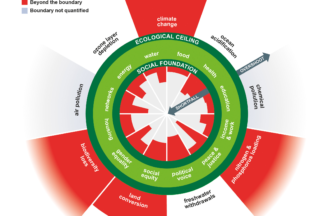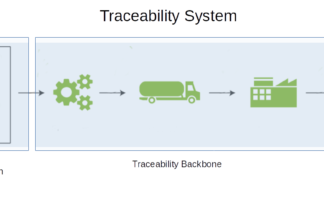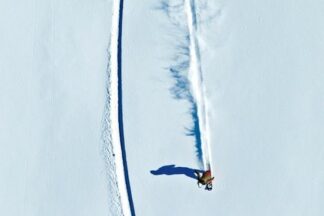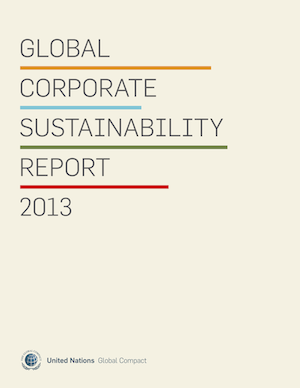In an earlier post I asked: How can business, a business, downscale the Doughnut and make it operational?
In this post I look at three tools that praise themselves of being either part, or even all, of the support a business needs on the journey to integrate the Doughnut Economics concepts. Namely: Science-based Targets (SBTs), the B Impact Assessment(BIA), and the Future Fit Business Benchmark (FFBBM).
What are their fundamental differences and similarities?
Are they indeed a tool to help on the path to keeping within the Doughnut boundaries?
In a recent blog post, we referred specifically to ‘eco’ labels that you may find on an outdoor product – or its hang-tag. Of course the key question is: what labels that you may encounter when shopping for alpine kit, are (reasonably) trustworthy?
Here an overview.
Authentication and traceability backbone solutions have become a key technology for many a brand to prevent not only product forgery, but also to prove truthfulness of on-and-off product claims.
What few realise: product authentication is just one half of a 2-part system (Figure 1) whereby authentication is applied to the product at its point of origin, and a traceability backbone ensures that the product reaches its destination – for example the end consumer – safely and untampered.
Launched at the end of 2006, the Global Social Compliance Programme is a business-driven programme, and aims for continuous improvement of working and environmental conditions in global supply chains.
Detox has been a repeat topic on this blog. Most recently after my visit in May to Performance Days, but also previously.
While slowly but surely more and more brands (17 at the time of writing) – and retailers – have signed a Detox Solution Commitment with Greenpeace, and hence work in some way or other with ZHDC (Road map to Zero), a key threshold was passed event most recently: With the Italian fabric mill Canepa, the first manufacturer has taken the pledge.
n this post, I’ll be looking at the CSC Responsible Source standard, which aims very clearly at the issue of (un)ethical, (in)transparent supply chains. The standard exists for 2 very specific area of expertise: precious gems and metals; and man-made fibres and textiles.
The UN Global Compact (GC) report published at the beginning of September 2013, and which draws a conclusion on its achievements since 2007 (it was launched in 2000), shows that there is a behaviour-versus-statement gap at corporations. This is worrying.
Australia is a little bit like a big blank spot of knowledge as far as many of us here in Europe (and the US) are concerned.
The recently launched ‘Australian Fashion Report‘ is the first piece of work that looks very specifically at the sustainability and ethical trade practises of brands that are retailed in Australia, both local Australian as well as global brands.
The news is fresh. And it could potentially be some of the most interesting news in the present for cost savvy – and patience as well as unscrupulous investors looking for a somewhat different opportunity: High risk, yes, but potentially with outrageously high returns.
Things in North Korea, secluded for the last 60 years, are undoubtedly changing.
2 weeks after the Rana Plaza’s disaster in Bangladesh, the death toll has risen to 921 and the fire broke in another garment factory last night killing 8.
But how have these fashion brands reacted to, possibly, the worst known disaster in the history of the global apparel industry?
In Medieval times the location of a tannery was heavily based on the requirements of a nearby river or stream, cattle which could supply the hide, and of course oak trees which would supply the bark needed for the tanning process. In the present, because of the demand for luxury at the cheapest possible prices, the industry is pushed out to where it is easier to ignore the moral and environmental reek.
In a recently published consumer study 52% percent of U.K., U.S. and Canadian consumers believe that businesses’ alignments with social...
The reaping (black market) trade in reptile skins for the luxury fashion and accessories market is an openly talked about, albeit ugly, reality of the present.
The recently published UNCTAD BioTrade report and toolkit provides useful and pragmatic info for designers.
At the Copenhagen Fashion Summit 2012 the NICE Code of Conduct and Manual was, in collaboration with the UN Global Compact, officially launched. A review of this document, and the impact it may, or not, have onto the fashion industry it is targeting.
The issue of wages in the fashion supply chain is a never ending story: the paid wages, the unpaid wages, those that suffice, or not, for a livelihood. tackles this issue in a very thorough, and at the same time visionary way by laying out a practical frame work for a Fair Wages
London Fashion Week 02/2011 - Day 2: EstEthica is successful so it seems. But what is there going on behind the scenes? Some controversial and critical insights.
Winter 2011, D2: TheKey.to, Berlin. The discovery of the ethical sourcing platform Source4Style & a global textile waste mapping campaign 'Trash2Trend'.
The task was easy, so one would think: Shop for a sensible winter-apt overcoat as ethically as possible and at a reduced budget. But nothing is easy in fashion!
With Grameen, Uniqlo has found the perfect partner to do business with the BOP.
Last of an article series that analyses Uniqlo and why it joint forced with Bangladesh's Grameen Bank.
When looking underneath the surface of the Japanese fashion industry, a fundamental shift is taking place: Production is shifted back to the Japanese home land.






